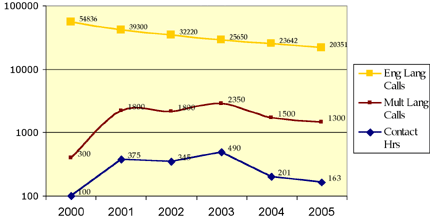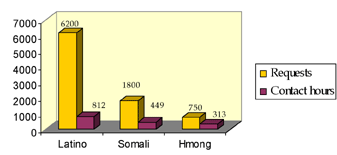October 2007 // Volume 45 // Number 5 // Ideas at Work // 5IAW1
Engagement in English Language Learner (ELL) Latino, Hmong, and Somali Communities
Abstract
Research documents the importance of engagement between universities and potential learners. Yet more studies are needed to determine community engagement efficacy with underserved communities, especially English Language Learners. This article shares the importance of using various types of engagement. For instance, multicultural students hired by the University of Minnesota Extension INFO-U answer service to work in their respective communities worked with advisory boards, made community visits, and conducted focus groups. All affected the number of INFO-U's callers and Web visitors. Some groups were more likely to use INFO-U's services after engagement. For others, automation was not a cultural fit.
Introduction
Changing demographics give Extension opportunities to serve new audiences, including non-English speakers. The 2000 Census shows that 47 million people over 5 do not speak English at home (Census 2000). Between 23% and 37% of students in Minnesota's two largest cities don't speak English as their first language at home (MN Department of Education, 2005). This high English Language Learner population (ELL) prompted the University of Minnesota Extension INFO-U program to provide community, family, and environment information through pre-recorded, multiple-language phone messages.
Congruent with national trends, Spanish is Minnesota's dominant non-English language. Hence, INFO-U partnered first with Hispanic/Latinos. Whereas nationally Chinese is the next most prevalent language, Minnesota has many Hmong and Somali immigrants (Census.gov, 2003). In 2001, the Dean provided a $150,000 grant to bring INFO-U content to Minnesota's top three ELL communities. The Center for Urban and Rural Affairs (CURA) funded students' community engagement activities.
Addressing critical issues by developing interpersonal relationships between students, staff, and communities is documented by CURA (Robillos, 2001), Robert Bringle, Julie Hatcher (Bringle & Hatcher, 2002), and others (Hassel, 2005; Guion, 2004). Similarly, INFO-U's Community engagement through interactions with students who shared cultural characteristics of communities added depth to the grant's goal of providing usable, inexpensive, and reliable resources for new audiences. By hiring bi-lingual Hmong, Hispanic/Latino, and Somali students, Extension gained cultural understanding for future programs. By helping to develop culturally appropriate materials, students built trust with audiences. Finally, student engagement increased and sustained interest in Extension throughout the project's duration.
Community Engagement
The coordinator used referrals from educators to contact leaders within the communities and people who served these populations. Task forces were formed. Hmong and Hispanic/Latino meetings were held at Extension offices, whereas the Somali group chose to meet at Somali community centers. Groups discussed INFO-U's 600 topics and chose topics for their communities. New topics, such as Immigration and Preparing for Winter, were added. Participants listened to messages for cultural appropriateness, and we made changes before translating them.
Task groups and the university's multicultural student centers referred students to the coordinator. She interviewed and hired community program assistants to work in their communities up to 20 hours a week. For one third of their hours, they translated documents, wrote reports, and conducted focus groups. For the balance, they visited community sites and participated in community events. Most outreach was conducted in the St. Paul/Minneapolis metropolitan area. Each student spent 1 to 4 days in greater Minnesota. Each visited 20-25 sites a week, emphasizing that the services were:
- Free
- Available 24-hours a day on the phone or via the Internet
- Available in four languages (English, Spanish, Hmong, and Somali).
From 2001 to 2005, the students and coordinator visited approximately 800 agencies to promote Extension programs and offer hands-on demonstration of how to use INFO-U.
Focus Groups
Students worked with respected agencies and Extension workers to recruit focus group participants. Twenty groups were conducted by the trained students in the language that the community spoke. The students played 60 Spanish, 39 Hmong, and 34 Somali messages about food, health, education, parenting, community, money, and housing. Groups heard four to six topics and evaluated them. They responded to questions:
- Is the speaker's voice clear with good volume? (Yes/No comment)
- Do you understand the information? (Yes/No comment)
- Is it helpful? (Yes/No comment)
- Will you call to learn additional information? (Yes/No)
- Are there additional topics that you would like? (Comment)
Participants received $25 gift certificates to local stores.
There were 111 focus group participants. In respect to cultures, most groups were segmented by gender (Detzner, Senyurekli, Yang, & Sheikh, 2005). For Spanish, nine groups were conducted and 51 participants. Groups ranged from low-income, rural women, to women over 40 who had been here several years, to young adults in the U.S. less than 6 months, to professionals who spoke Spanish as their first language. In all groups, Immigration, Where to Get Medical Services, and Employment emerged as most needed topics.
There were seven Hmong groups and 40 participants. They included women between 25-45, teens, and a group of men and women who had lived in the U.S. less than one year. Many participants were interested in Parenting and Education, and wanted more information on how to parent the American way but still maintain Hmong traditions. New refugees were interested in Renter's Rights.
There were four Somali groups and 20 participants. They ranged from leaders, to elderly men, to women and young mothers. Women were more interested than men in Parenting and requested information about raising Teenagers in the U.S. Somalis had high interest in Immigration, Housing, and Nutrition (Newman & Smith, 2003).
Content Delivery
The coordinator responded to requests, like revoicing Breastfeeding with a female speaker in Spanish, improving sound quality, and adding topics. Figure one shows a revision that starts in familiar ground for cross-cultural audiences.
| Hmong
Back in Laos, dating typically occurred while the parents were in bed sleeping. Young men would venture out to the homes of the young women that they liked. The men would talk to the women through their bedroom walls. The men would sometimes play the traditional instrument, the ncas, to lure out the women so they could talk face to face and get to know each other better. Dating rarely occurred in the presence of parents, except during special events such as the Hmong New Year. During Hmong New Year, men and women attracted one another with folk songs and ball tossing. Parents observed and helped their daughters select the right person to court. In America . . . | Somali
When we were in Somalia, dating took different forms. In the rural areas, boys were in charge of raising camels and girls raised the goats and sheep. Young people met when grazing on the same land. In the cities, young men would visit neighbors to see the daughters. It was usually assumed that this was a serious relationship that would lead to marriage. In other cases, the parents arranged marriages--so dating did not take place. Here in the United States . . . | Spanish
Based on our experiences and that of our friends from new countries and cultures, we have various ideas of when teens should start to go out with friends and also to date. Here in Minnesota, there are many diverse situations. There are things to talk about with your teen . . . | English
When are teens ready to date? At some point in adolescence most American teens begin to date. This is an important and personal decision. . Continued discussion with your teen will help you feel more certain about when your teen should start dating. |
Once content additions and revisions were complete, bilingual brochures--with graphics to help readers navigate--were produced. The brochures explained how to use INFO-U. One four-language brochure was produced. The students brought brochures to government offices, non-profit organizations, libraries, schools, and health clinics.
Because some people were not functionally literate in their own language, Spanish and Somali CDs were produced. CDs were public service announcements and paid ads on non-English radio. Production and airtime costs were significant compared to print materials, without increasing numbers of callers. Therefore, Hmong CDs weren't produced. Bilingual releases were sent to newspapers in all communities.
Finally, the students and coordinator brought displays to community events. Whenever possible, displays were staffed. Students responded to many questions and made referrals to other U of M programs. Thus, events were gateways to other programs.
Summary
From 2000 to 2005, students, professors, Extension professionals, and outside collaborators produced 120 culturally appropriate phone messages and Web documents. INFO-U processed 8,750 non-English calls and experienced an estimated 100,000 Web visits. Results are applicable to others considering ELL engagement.
- Most people appreciated information in their language.
- Daily living topics like housing, immigration, nutrition, and parenting garnered high interest in all communities.
- Professionals who worked in the communities were enthusiastic about content, because it was culturally sensitive.
- Community engagement and promotion resulted in more calls (Figure 2).
Figure 2.
Hours of Engagement Compared to
Number of Calls

Quantitative data was congruent with focus group findings (Figure 3). Latinos verbalized the highest interest in using INFO-U, and they had the most calls. They produced 6,200 calls, which is equivalent to 4% of the MN's Latino population. There were 1,800 Somali calls, about 14% of Minnesota's Somalis (Census 2000). The Hmong indicated the least interest in an automated system, and they produced 750 calls, just 2% of Minnesota's Hmong population (MN State Demographic Center, 2006).
Figure 3.
Total Hours of Engagement in
Target Communities vs. Number of Requests for Information 2000-2005

During the introductory year there were three calls per contact hour. Once people were familiar with INFO-U, calls per student-contact hour rose to five in 2003 and to eight in 2005. Perhaps the increase occurred because later visits were repeat visits or reminders that INFO-U was still present. It's assumed some people called more than once. As time moved on and funding decreased, contact hours decreased along with the number of calls. When participants became more versed in English, they may have migrated to the Web, similar to their English speaking counter parts, as indicated by data analysis of INFO-U's Web visits in a separate report (Newman, 2007).
Based on INFO-U's experiences, suggestions for others who plan to work in ELL communities include:
- Hire people from these communities.
- Develop partnerships with stakeholders.
- Assess the needs of the intended audiences with advisory and focus groups.
- Adapt Extension materials so that they are culturally appropriate.
- Stay engaged in the community for longer-term effects.
- Speak the community's language.
References
Bringle, R. D., & Hatcher, J. (2002). Campus-community partnerships: The terms of engagement. Journal of Social Sciences [On-line], 58 (3). Pp 503-516. Available at: http://www.spssi.org/jsi.html
Detzner, D., Senyurekli, A., Yang, P., & Sheikh, K. (2005 November). Immigrant family strengths: A qualitative study of Somali and Hmong families. Paper presented at the 67th Annual National Council on Family Relations Conference, Phoenix, AZ.
Guion, L., Chattaraj S., & Lytle, S. (2004). Strengthening programs to reach diverse audiences: A curriculum to planning and implementing Extension programs for ethnically diverse audiences. Journal of Extension [On-line], 42(1). Available at: http://www.joe.org/joe/2004february/tt7.shtml
Hassel, C. A. (2005). The craft of cross cultural engagement. Journal of Extension [On-line], 43(6). Available at: http://www.joe.org/joe/2005december/ent-a.shtml
Minnesota Department of Education (2005). Academic excellence: School report card. [On-line].Available at: http://education.state.mn.us/ReportCard2005/
Minnesota State Demographic Center. (2005). Minnesota population projections by race and Hispanic origin 2000-2030. [On-line]. Available at: http://www.demography.state.mn.us/DownloadFiles/PopulationProjectionsRaceHispanicOrigin.pdf
Newman, D. (2007). INFO-U Web statistics comparison 2000 to 2005/2006 (unpublished). Minneapolis, MN, University of Minnesota.
Newman, D., & Smith, F. W. (2003). Project update: Bringing INFO-U to new audiences. CURA Reporter, 33 (23). Available at: http://www.cura.umn.edu/reporter/03-Summ/INFO-U.pdf
Robillos, M.U. (2001). Somali community needs assessment project. Minneapolis, MN: University of Minnesota. CURA Reporter, 01 (4). Available at: http://www.cura.umn.edu/publications/Robillos_Somali.pdf
US Census (2003). Language use and English speaking ability 2000. (2003). [On-line], Article CKBR-29. Available at: http://www.census.gov/prod/2003pubs/c2kbr-29.pdf
